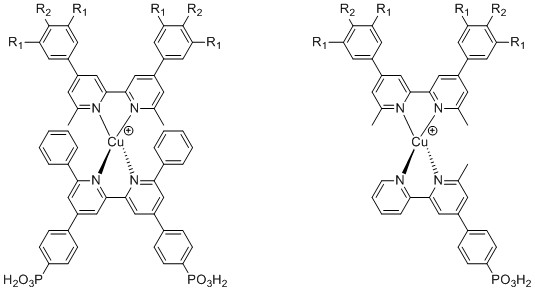Combining an asymmetric acid functionalized anchoring ligands with symmetric ancillary ligands in bis(diimine)copper(I) dyes in dye-sensitized solar cells
The development of n-type dye-sensitized solar cells (DSCs) has made significant progress incorporating copper(I)-based dyes in order to replace the highly studied ruthenium(II) sensitizers used in conventional Grätzel cells which were first reported around two decades ago. Replacing the ruthenium(II) sensitizers by copper(I) dyes is of high interest in order to use more abundant materials and shift from rare metal sources on earth. Each copper dye has the composition [Cu(Lanchor)(Lancillary)]+.
We have recently shown that by introducing phenyl substituents in the 6,6´-positions of the bipyridine anchoring moiety Lanchor, the light absorption can be improved towards the red-end of the visible spectra. Additionally, the bulkier substituents help to shield the copper(I) centre.
Even though we could overcome the problem of having a low spectral response in copper(I) based dyes by using our new anchoring ligand, a drawback was the bleaching of the heteroleptic dye adsorbed on the electrode surface which comes along with a low performance of the dye-sensitized solar cells. In order to overcome this problem we synthesized a series of 6-methyl-4-phenyl-2,2´-bipyridine asymmetrical ancillary ligands to remove the problem of steric crowding in the copper(I)bis(diimine) coordination sphere. Unfortunately the asymmetrical framework of the ancillary ligand in combination with the bulky anchoring ligand results in a low power conversion efficiency of the DSCs.
Following the results we achieved by combining the asymmetrical ancillary ligands with a phosphonic acid anchoring ligand we have now investigated the symmetrical analogues of these bpy-based ancillary ligands to quantify their performance within a dye-sensitized solar cell. [1]
The combination of these new ancillary ligands with the bulky anchoring ligand did not boost the solar to power conversion efficiency as expected.
Therefore we investigated an asymmetric acid functionalized anchoring ligand to combine it with the symmetric series of ancillary ligands.

[1] A. Büttner, S. Y. Brauchli, R. Vogt, E. C. Constable and C. E. Housecroft, RSC Adv. , 2016, 6, 5205-5213.